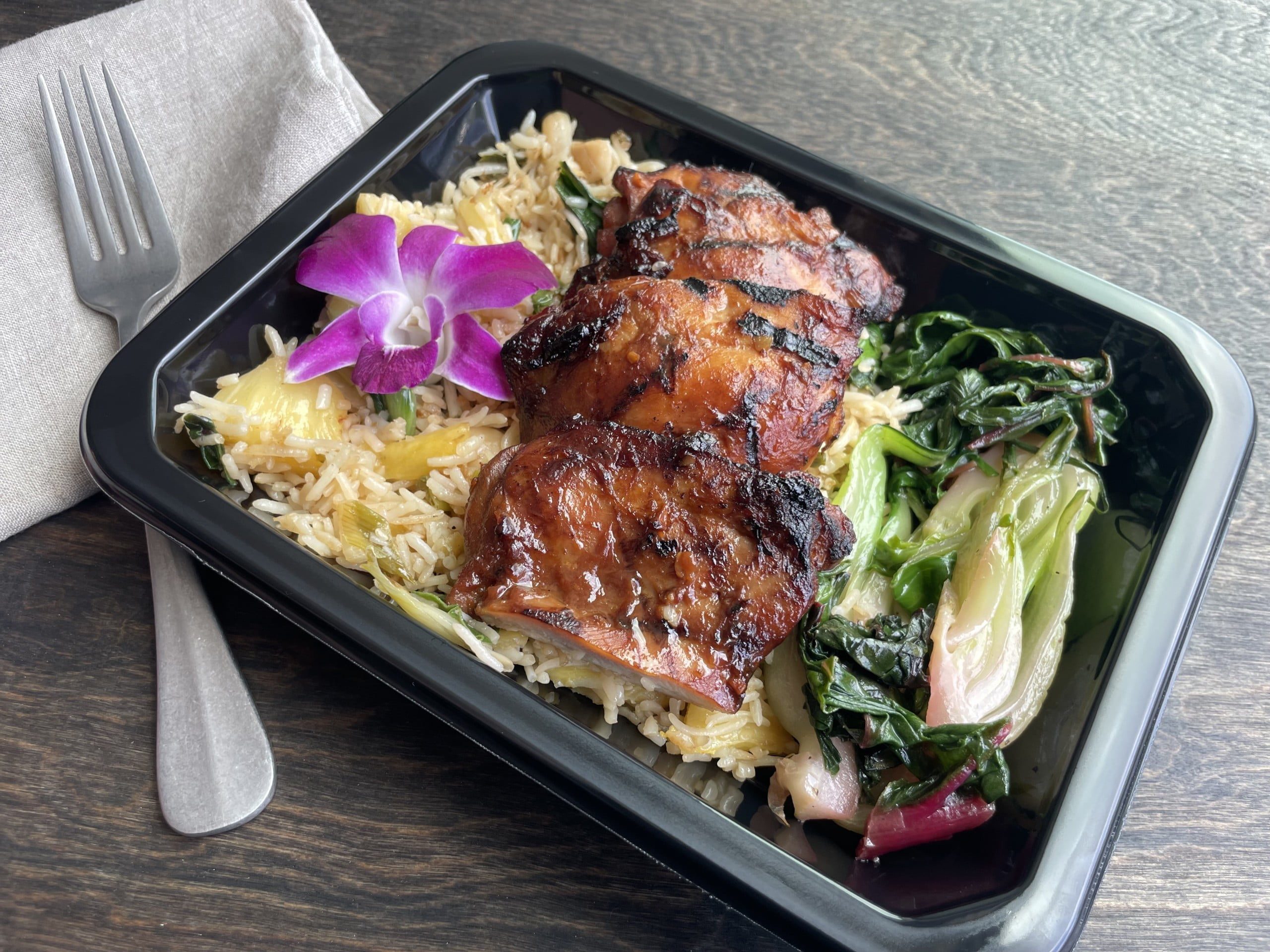
Take your tastebuds on a Hawaiian Vacation
Summer just got here, and this heat already has us dreaming of a sweet island getaway. That’s why this month we turned to the beautiful
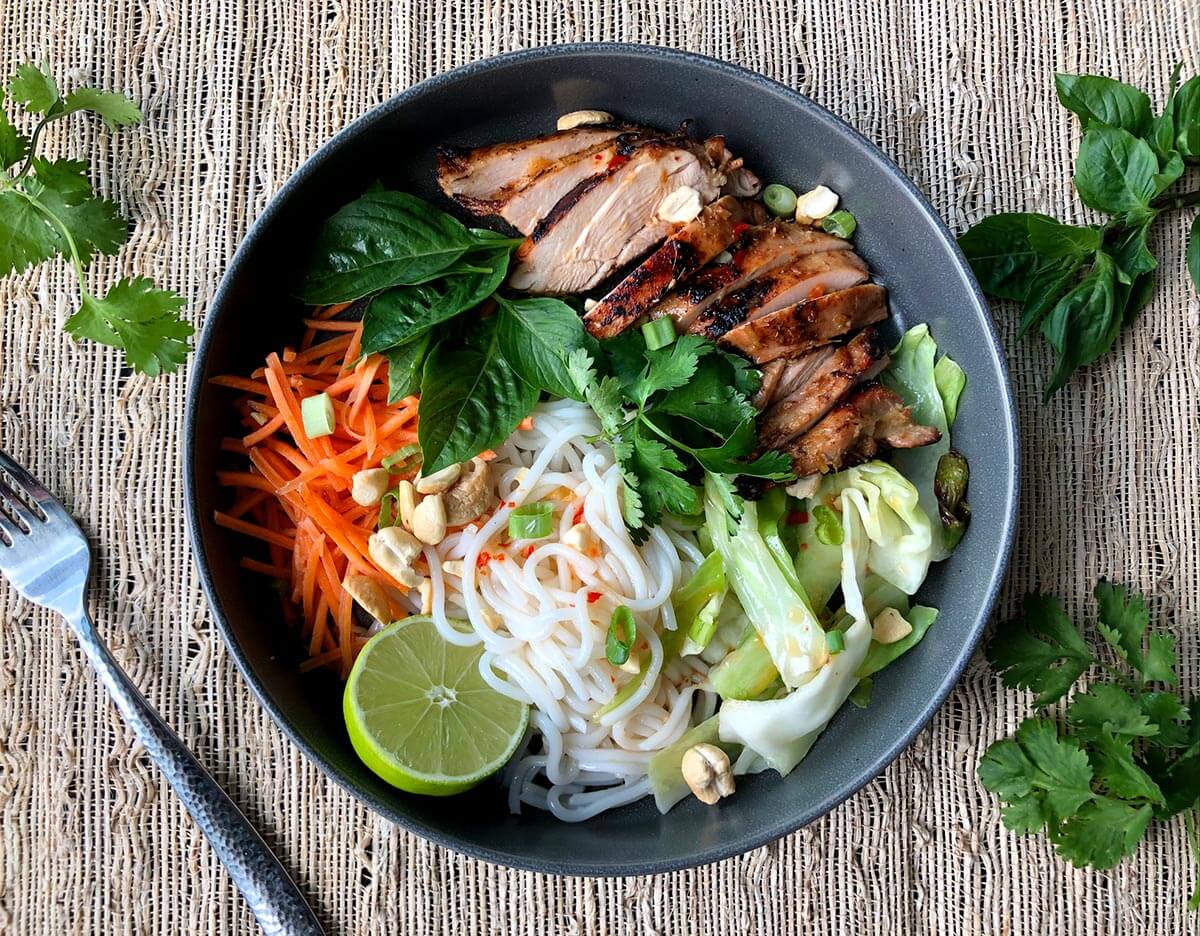
Featured Above: EatFlavorly’s House Made Lemongrass Vermicelli Chicken, check it out here!
Vietnam is located in Southeast Asia, in a region known as Indochina. It hugs the coastline of the South China Sea and borders Laos and Cambodia to the west. In America, Vietnam is sadly known less for its cuisine and more for the notoriety of the 20 year Vietnam War. In fact, many aspects of its culture, including a diverse and impressive gastronomy, are relatively unexplored. Happily, this is beginning to change as Vietnamese cuisine has been steadily gaining popularity in the West. Why the appeal? You could say it is due to its simplicity, multicultural influences and healthiness. You could also say it is a cuisine governed by philosophy, bound by regional geography and shaped by history. Either way, it is a stimulating, technicolor experience for all five senses and one that stands out from its South East Asian neighbors. Let’s explore some reasons why.
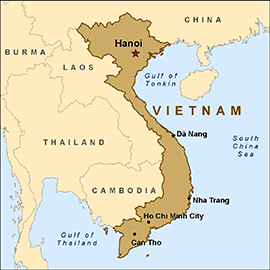
Vietnam borders the Gulf of Thailand, the Gulf of Tonkin, and the Pacific Ocean, in addition to China, Laos, and Cambodia. The skinny, elongated, S shaped country has a north-to-south distance of 1,650 km (1,030 mi) and is about 50 km (31 mi) wide at the narrowest point. As a result, its climate, topography and bordering neighbors impact its food culture in different ways.
In northern Vietnam, a colder climate limits the production and availability of spices. As a result, the foods there are often less spicy than in other regions. Consequently, black pepper is used in place of chilies. In general, northern Vietnamese cuisine is mild, light and balanced and the use of meats is relatively small. Freshwater fish, crustaceans, and mollusks, such as prawns, squid, shrimp, crabs, clams and mussels are widely used. Many notable dishes of northern Vietnam center around crags (e.g., bún riêu). Fish sauce, soy sauce, prawn sauce, and limes are among the main flavoring ingredients. Regarded as the cradle of Vietnamese civilization, northern Vietnam for the most part produces many of Vietnam’s signature dishes.
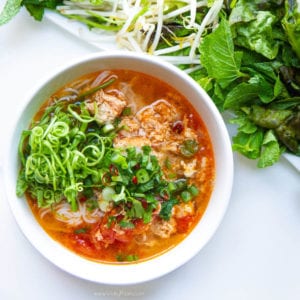
The abundance of spices produced by Central Vietnam’s mountainous terrain makes this region’s cuisine notable for its spicy food. Once the capital of the last dynasty of Vietnam, Huế’s culinary tradition features highly decorative and colorful food. Indeed, this reflects the influence of ancient Vietnamese royal cuisine. The region’s cuisine is also notable for sophisticated, complex dishes in small portions. Chili peppers and shrimp sauces are among the most common ingredients.
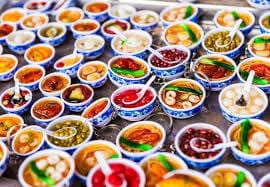
As you move south, there’s more flavor-blending with nearby Thailand and Cambodia. The tropical climate and fertile soil down south also sustains more rice paddies, coconut groves, jackfruit trees, and herb gardens. As a result, foods in southern Vietnam are often vibrant and flavorful, with liberal uses of garlic, shallots, and fresh herbs. The food in southern Vietnam is typically sweeter. Consequently there are sweeter broths for pho, more palm sugar in savory dishes, and popular taffy-like coconut candies using coconut cream. Food in Southern Vietnam tends to be sugary. The preference for sweetness in southern Vietnam can also be seen through the widespread use of coconut milk in its regional cuisine. Vast shorelines make seafood a natural staple.
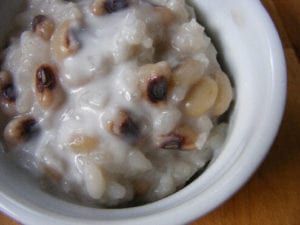
Neighbors have influenced Vietnamese cuisine significantly throughout history. One of the first examples of this is the Mongolian people who invaded Vietnam from the north in the tenth century. They soon introduced beef to the Vietnamese diet. Common Vietnamese beef dishes are pho bo (Beef Noodle Soup) and bo bay mon (Beef Cooked Seven Ways).
The Chinese, who dominated Vietnam for 1,000 years, taught the Vietnamese people cooking techniques such as stir frying and deep frying, as well as the use of chopsticks. In the south, neighboring countries Laos, Cambodia, and Thailand introduced flat, Cambodian style egg noodles, spices, chili, and coconut milk.
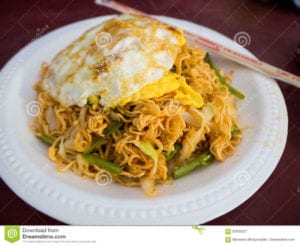
Beginning in the sixteenth century, explorers and traders introduced foods such as potatoes, tomatoes, and snow peas. Later, when the French colonized Vietnam (1858–1954), they introduced foods such as baguettes (French bread), pâté, coffee with cream, milk, butter, custards, and cakes. Perhaps the most surprising French influence is the soup that seems emblematic of Vietnam cuisine itself: pho. Pho is a combination of Vietnamese rice noodles and French meat broths. In fact, some even say that the name pho, pronounced ‘fuh’, may be a Vietnamese appropriation of the French pot au feu or stew.
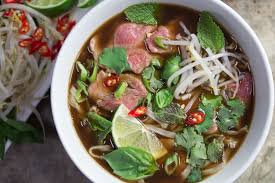
Vietnamese cuisine focuses on preparing food with the freshest of ingredients and uses meat mainly as a condiment. It is also done with minimal use of oil and dairy and relies more on the light, fresh flavors of herbs and vegetables. As a result, Vietnamese cuisine is one of the healthiest cuisines in the world.
Rice is the most important component of Vietnamese agriculture and cuisine. It is an object of worship in many temples of Vietnam. It is said to originate from the ‘Mother Goddess Worshipping’, the most long–standing belief in Vietnam. Moreover, in ancient Vietnamese, the very first written characters that mean happiness are images of rice plants and a square symbolizing a paddy field.

Accordingly, many main dishes and snacks in Vietnam are made from rice. Boiled rice, rice porridge, steamed rice, glutinous rice cake, Banh Chung (square cake) are examples. Even the well known Pho Noodle Soup is made from rice. Vermicelli is an extra-thin rice-based noodle that is quick-cooking and good with countless flavors. Sometimes labeled as rice noodles they are not the same as Italian vermicelli, which are made from Durum wheat flour. Generally, rice is the center of everything, and many Vietnam rice varieties are exported all over the world.
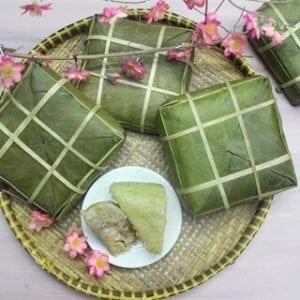
Most salt intake in the Vietnamese diet comes in the form of fish sauce. Salty, funky, fermented fish sauce, or nước mắm in Vietnamese, occurs in marinades, soup broths, salad dressings, spring roll dips, and other dishes. The national condiment is nước chấm, comprising fish sauce that is diluted slightly with a splash of lime juice, sugar, chilies and garlic. In Vietnamese culture, fish sauce is symbolic of gathering, reuniting and sharing. Generally during a meal, fish sauce sits in the center of the table and everyone present shares it.
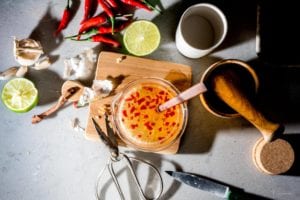
Vietnamese food makes extensive use of fresh herbs, spices, and aromatics. Sometimes they go into a steamy pot of pho, sometimes wrapped into spring rolls. Otherwise, they may go into a banh xeo pancake. The freshness of each ingredient is crucial. Some of the most regular herbs include cilantro, basil, mint, lemongrass, lime leaf, garlic chives, ginger and galangal.
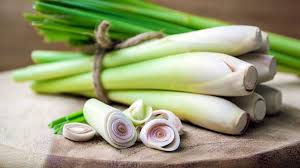
The Vietnamese cook with unripe fruits in the same way as vegetables. A green papaya or banana flower, for example, becomes the base for salads in lieu of leafy greens. Usually a bit sour, the unripe fruit pairs nicely with fish sauce, chili, garlic, dried shrimp, and finely chopped peanuts. Ripe fruit, on the other hand, is a common dessert. Instead of cakes or cookies to end a meal usually it ends with hot tea and above all a big platter of indigenous fruits. To illustrate, slices of banana, mango, pineapple or watermelon might be served. And, the redder the insides, the more good luck awarded to you! Other fruits might include dragonfruit, papaya, rambutans, and lychees.
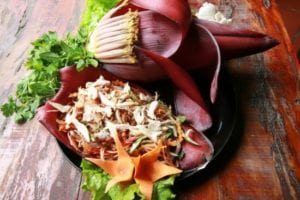
Soup is customary for breakfast in Vietnam – big bowls of steaming noodle soup, with meat and any number of additional ingredients. These might include flavorings such as bean sprouts, cilantro, basil, chili peppers, lime slices, or green onions. The soup is spicy with with plenty of fish sauce (nuoc mam), chili-garlic sauce, and/or hoisin sauce in nearby dipping dishes. As a result, it is an unusual melange of rice noodles, raw vegetables and herbs. Raw meat slices or seafood cook in the broth in the final stages of preparation. Pho noodle soup is hugely popular in the US. The term pho translates as “your own bowl,” since it is one of the few meals where the food does not pass around for sharing.
‘Small’ soups, by contrast, appear as first course. They generally don’t have noodles and are known as sup. For example, the famous Sup Mang Tay, or Crab and Asparagus Soup is in this category. In addition, there is Sup Nam Trang, a complex mixture of crab, shrimp, and dried white fungus (mushroom-like).
Finally, the class of soups known as Canh are generally a large family style serving, out of one big bowl. And they are generally light; a first course to whet the appetite. These include Canh Sa Lach Soan (Watercress-Shrimp Soup), Canh Chua Tom (Hot and Sour Shrimp and Lemongrass Soup), and Canh Chua Ca (Hot and Sour Tamarind Fish Soup).
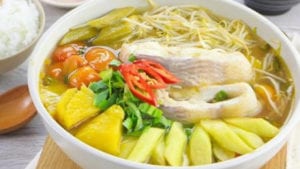
Vietnamese cuisine gives great importance to balance and the accurate combination of different flavors and ingredients. Consequently, the philosophy of balance translates into five taste elements — spice, sour, bitter, salt and sweet. According to Vietnamese culinary tradition, each of the tastes corresponds with an organ of the body. These in order include gall bladder, small intestine, large intestine, stomach and bladder.

The importance of the number five doesn’t stop there. Cooks also try to include five types of nutrients — powder, water, minerals, protein and fat, as well as five colors — white, green, yellow, red and black — in every dish. Therefore, the resulting dishes are in balance, colorful and appealing to all five human senses. Consequently, Vietnamese cuisine is comparable to European ‘Nouvelle Cuisine”. In brief, it is a lighter, delicate approach to preparing food with an emphasis on visual presentation.
This sense of culinary balance extends to a trade-off between the “heating” and “cooling” properties of ingredients. Such properties might not be immediately obvious to western diners. Duck meat, for example, is ‘cool’ and is thus popular in summer with ginger, which is ‘warm’. Likewise, Chicken, on the other hand, is ‘warm’, so it’s usually a winter food, alongside a sour sauce, which is ‘cool’.
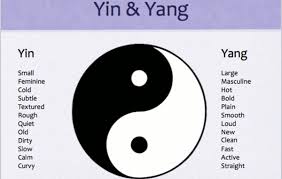
Probably one of the most famous Vietnamese dishes, pho as mentioned is a steaming noodle soup dish that is traditionally a breakfast food. It contains rice noodles, bone broth and plenty of fresh herbs. You then add chili, limi and hoisin sauce to taste. There is Pho Ga (chicken) and similarly, Pho Bo (beef).
This hearty noodle dish is native to Hoi An, where lye water from a nearby well is used to make the noodles. Thus, it is unique to this location because of this. Cao Lau noodles come topped with slices of barbecue pork, pork crackling, bean sprouts, lettuce and herbs, and crispy deep fried squares of those tasty noodles.
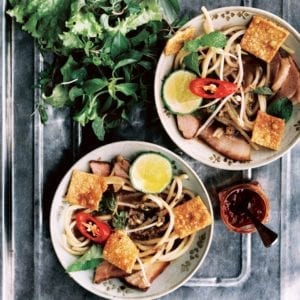
Bánh mì stalls are in evidence all over the country, serving this simple sandwich. In this case, the French influence comes into play: It is a soft, fresh baguette, with pate, pork, fresh herbs, pickle carrots and chilli.
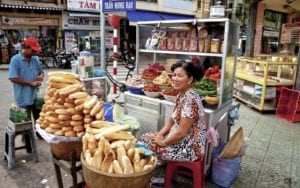
Another local Hoi An dish, these are delicate dumplings that look like white roses, hence the name. Locals fill the translucent white dough with spicy mince shrimp or pork and gently steam the dumplings. They also come with crispy shallots on top and a tangy dipping sauce.
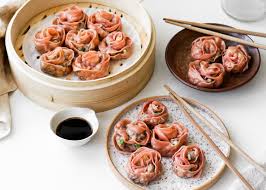
Egg coffee is a unique coffee treat from Hanoi that is sweet and rich. Cà phê trúng is a rich Vietnamese coffee base with frothy egg yolk and condensed milk on top. There are plenty of places in Hanoi to try it. For instance, the most famous is the original Cafe Giang.
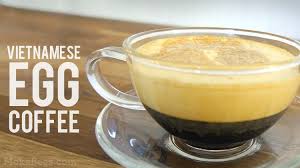
This famous street food is a crispy Vietnamese take on a savory pancake. The batter consists of rice flour and coconut milk with turmeric. First, they then fill it with pork strips, shrimp, bean sprouts. Next, they add in spring onion and fry it to perfection.
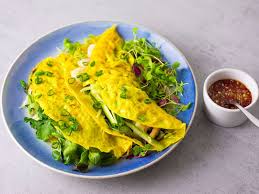
We hope we have whetted your appetite for Vietnamese cuisine. Together with its spectacular array of colorful ingredients, it is one of the most nutritious and perfectly balanced food cultures in existence. Furthermore, the recipes are simple to put together and the cooking methods are among the healthiest. For this reason everyone should try it. Even if you’ve never tried Vietnamese cuisine, we encourage you to try something different. EatFlavorly’s Lemongrass Chicken Vermicelli is waiting for you! We deliver frozen meals directly to your home with no subscription required.
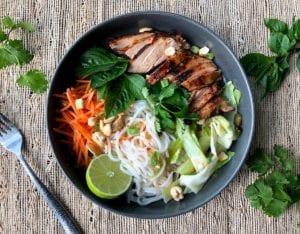
https://vietnam.travel/things-to-do/recipes-from-vietnam
https://en.wikipedia.org/wiki/Vietnam
https://epicureandculture.com/vietnamese-cuisine-french-influence/
https://www.thejakartapost.com/life/2016/09/13/rice-vs-noodles-which-is-healthier.html
https://en.wikipedia.org/wiki/Vietnamese_cuisine
https://bigseventravel.com/2019/08/the-7-must-try-traditional-vietnamese-dishes/
https://theculturetrip.com/asia/vietnam/articles/8-things-you-didnt-know-about-vietnamese-cuisine/
https://www.seriouseats.com/2013/01/a-basic-introduction-to-vietnamese-food.html
https://www.citypassguide.com/blog/understanding-vietnams-history-through-food
https://asian-recipe.com/cuisine-evolution/history-of-vietnamese-food
https://explorepartsunknown.com/vietnam/8-essential-vietnamese-dishes/
http://www.royalheritagecruise.com/vietnam/vietnam-facts/vietnam-foods.html
http://factsanddetails.com/southeast-asia/Vietnam/sub5_9c/entry-3409.html
http://vietkitchen2013.blogspot.com/2013/01/journey-of-vietnamese-cuisine-northern.html
http://www.foodbycountry.com/Spain-to-Zimbabwe-Cumulative-Index/Vietnam.html
https://study.com/academy/lesson/vietnamese-culture-facts-food.html
https://www.exoticvoyages.com/blog/vietnamese-cuisine-culture-34470.html
https://www.vietnamonline.com/overview/food-culture.html
https://www.thespruceeats.com/how-to-cook-with-lemongrass-3217231
https://www.webmd.com/vitamins/ai/ingredientmono-719/lemongrass
https://www.chowhound.com/food-news/187696/rice-noodles-vermicelli-what-is-the-difference/

Summer just got here, and this heat already has us dreaming of a sweet island getaway. That’s why this month we turned to the beautiful
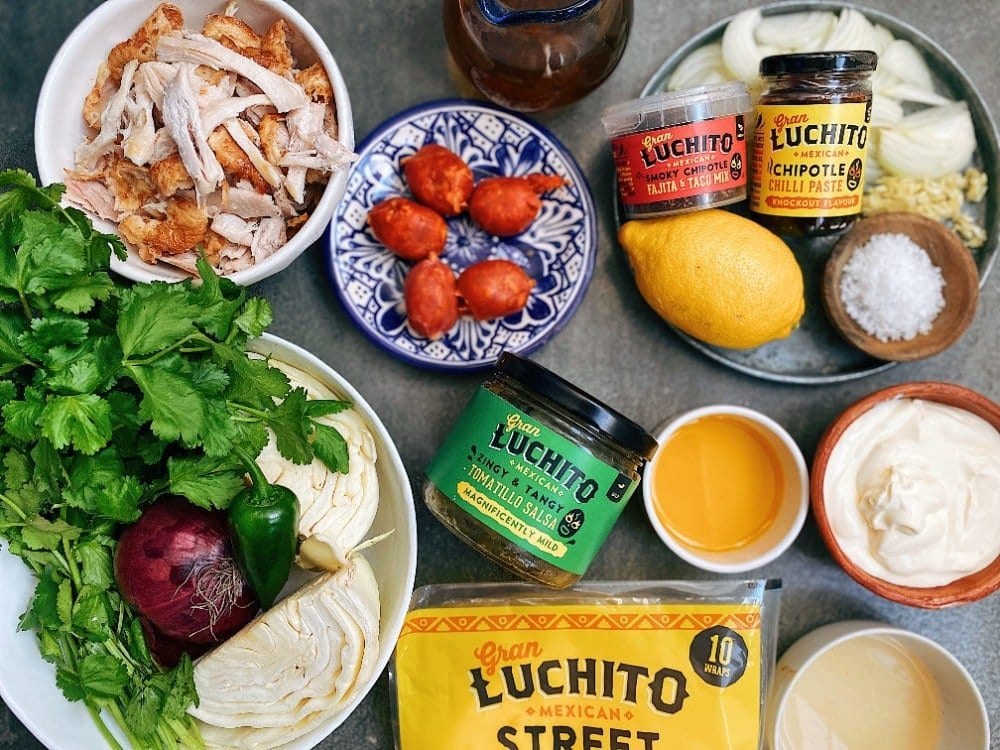
Check out how EatFlavorly utilizes Mexican meats and so many more in our scratch-made meals over at Our Menu! With Cinco de Mayo

National Earth day is approaching on Thursday April 22nd. Today, not only is Earth Day a day meant to increase awareness of environmental problems, but
The convenience of home meal delivery is undeniable. Getting food delivered to your door that does not require cooking or cleaning is a huge time-saver.